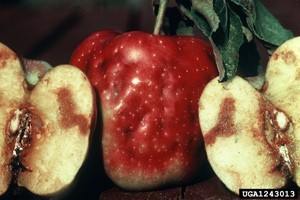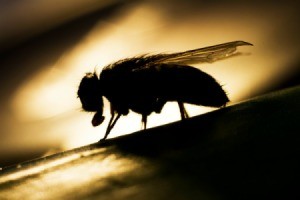
Identification
Apple maggots are legless, yellow-white in color and about 1/4 inch to 3/8 inch in size. Maggots hatch from eggs laid on the fruits by the parent flies. The mature maggots fall to the ground where they pupate and overwinter and emerge as adult flies the following June. The parent flies are slightly smaller in size than a housefly, dark in color and have transparent wings with dark bands. Apple maggots are found throughout the northern and central regions of the United States.
Favorite Plants
Apple maggots feed on apples, pears, blueberries and occasionally plums and cherries.
Damage
Pits and dimples form on the surface of fruit from egg laying that results in misshaped fruit. Maggots tunnel through the flesh of fruit, leaving a brown trail of decay and causing it to drop prematurely.
Organic Methods of Control:
Cultural or Mechanical
- Reduce populations by collecting and destroying dropped fruit on a daily basis until fall. Boil fruit to kill larvae before composting or seal in airtight bags and dispose of in the garbage.
- Select late-maturing cultivars. Early maturing varieties tend to be affected the most often.
Chemical
- Buy commercial apple maggot traps. Use 1 trap for every 100 fruit (1 per dwarf tree, 6 per full-sized tree). Make your own maggot traps from 1/4" to 1/2" thick wood cut into 5 1/2" by 9" panels or purchase plastic apples or apple-sized balls. Paint the wood or balls either a bright yellow or apple red color, attach a wires on either end for hanging and slip them into a clear plastic envelope or plastic baggie. Coat plastic with Tangle-Trap or another sticky substance and hang traps in tree branches on the outer third of the canopy near developing fruit. Secure both ends of the trap to prevent it from swinging and clear away leaves to prevent them from coming into contact with the sticky coating. Deploy traps in the spring and summer to trap adults. Remove and apply fresh bait to plastic every two weeks.

